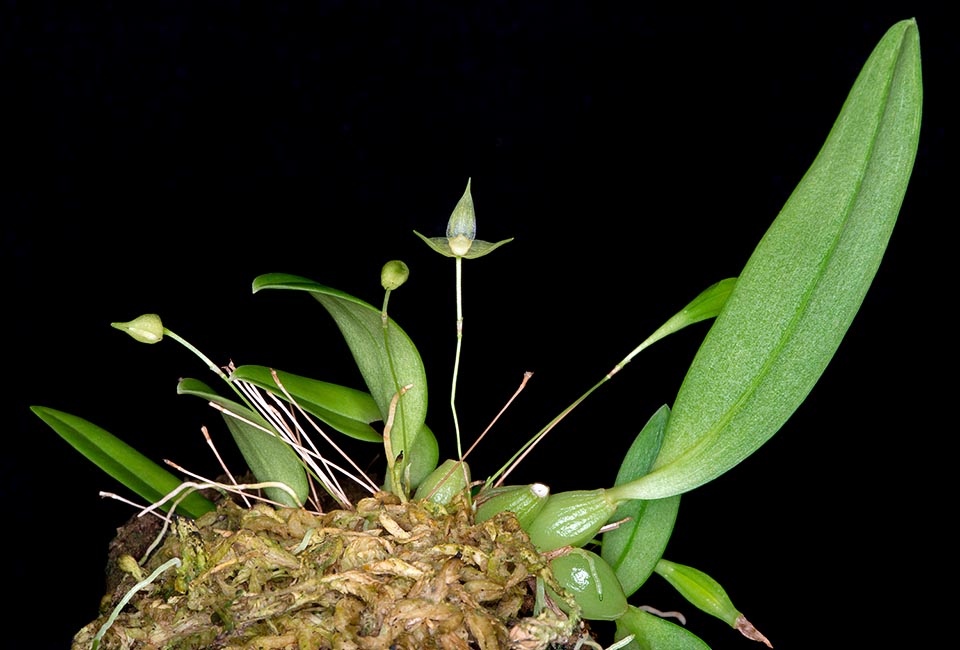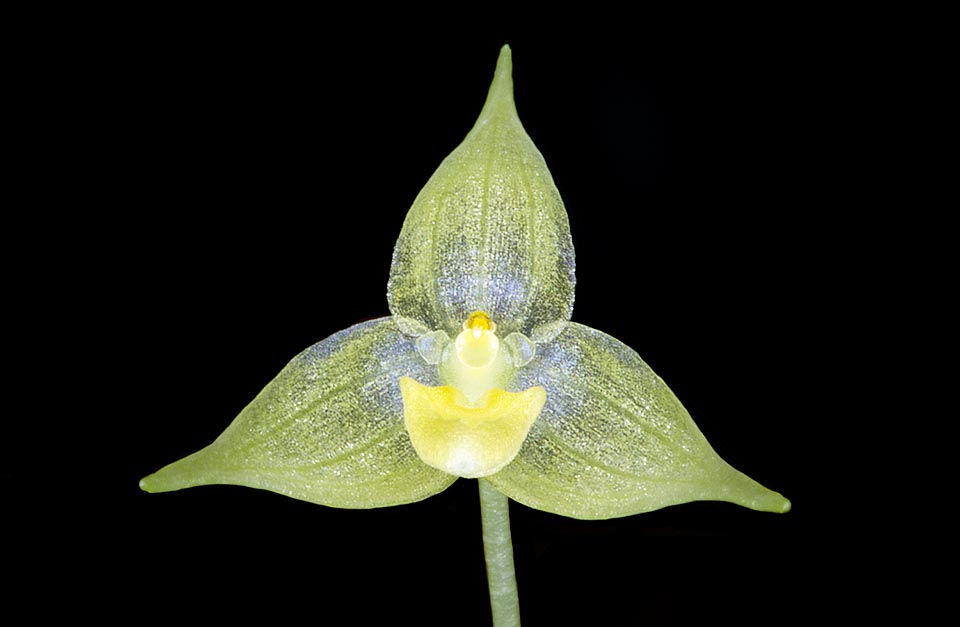Family : Orchidaceae

Text © Pietro Puccio

English translation by Mario Beltramini
The specie is native to the Fiji Islands, New Caledonia and New Guinea where it grows in the thick humid forests between the 200 and the 1000 m of altitude.
The name of the genus is the combination of the Greek substantives “βολβός” (bolbos) = bulb and “φύλλον” (phyllon) = leaf, with reference to the leaves growing at the apex of the pseudobulbs; the name of the species is the combination of the Greek adjective “ἀφανής” (aphanes) = invisible, indistinct and of the substantive “πέταλον” (petalon) = petal, with reference to the very small petals.
The Bulbophyllum aphanopetalum Schltr. (1906) is a 6-10 cm tall epiphytic species with creeping rhizome, of 1-1,5 mm of diameter, filiform roots and close ovoid pseudobulbs, 0,8-1,2 cm tall and of 0,3-0,6 cm of diameter, provided at the apex of only one oblong-elliptic leaf with acute apex, 3-6 cm long and 0,8-1,4 cm broad, of pale green colour, coriaceous and glossy.

The Bulbophyllum aphanopetalum is an epiphyte of the dense and humid forests of the Fiji Islands, New Caledonia and New Guinea © Giuseppe Mazza
Basal inflorescence, on a thin 3-7 cm long erect peduncle, with solitary flower, of about 1,8 cm of diameter, with yellowish green to pale yellow sepals and petals and yellow labellum. Almost similar sepals oblong-lanceolate with acuminate apex, 0,6-1 cm long and 0,2-0,4 cm broad, semiorbicular petals with obtuse to acuminate apex, about 0,5 mm long, ovate-lanceolate labellum with obtuse to acuminate apex, 0,3-0,4 cm long and 0,2-0,6 cm broad; clavate ovary 0,7-1 cm long.
It reproduces by seed, in vitro, but usually by division at the vegetative restart, with each section provided of at least 4-5 pseudobulbs.
Floriferous miniature orchid forming small compact tufts, requires a semi-shady position, intermediate temperatures, 20-30 °C, with night lowest ones not under the 16 °C, high and constant humidity, 70-80%, and air in constant light movement. Frequent waterings and nebulizations in presence of high temperatures, slightly more spaced with averagely low temperatures, leaving the substratum to partially dry up, utilizing rain water, demineralized or by reverse osmosis at ambient temperature.

Miniature orchid, forms small compact tufts, with numerous solitary flowers of about 1,8 cm of diameter © Giuseppe Mazza
Fertilizations, during the growth period, with a specific product for orchids, or a hydrosoluble balanced one, with microelements, at 1/4 the dosage shown on the package, appropriately alternated with the waterings to avoid accumulation of salts on the roots.
It is preferably mounted on small trunks, rafts of bark or of roots of arborescent ferns covered by a layer of sphagnum, can be cultivated also in pot or baskets with a compost formed by medium sliced bark fragments, sphagnum and inerts, like the polystyrene foam, in order to improve the drainage and the aeration of the roots.
The species is reported in the appendix II of CITES (species whose trade is internationally ruled).
Synonyms: Cirrhopetalum capillipes Guillaumin (1941); Bulbophyllum capillipes (Guillaumin) N.Hallé (1973); Peltopus aphanopetalus (Schltr.) Szlach. & Marg. (2001).
